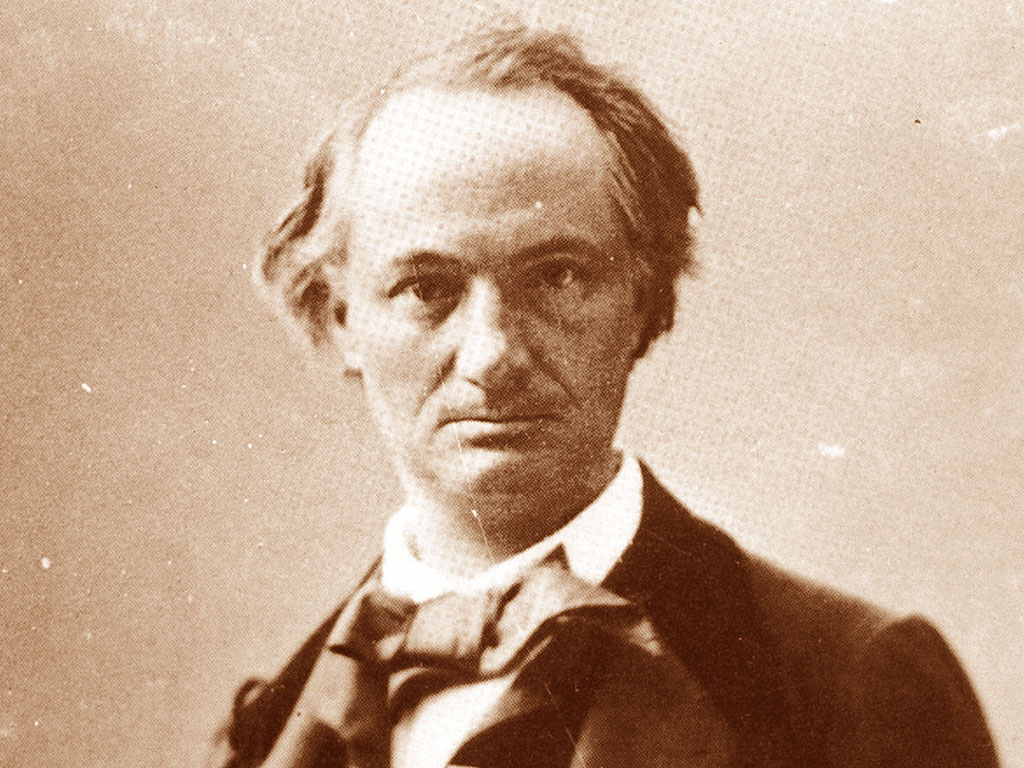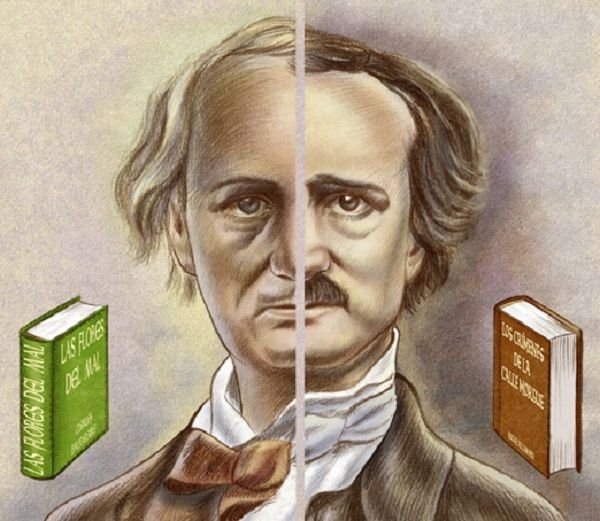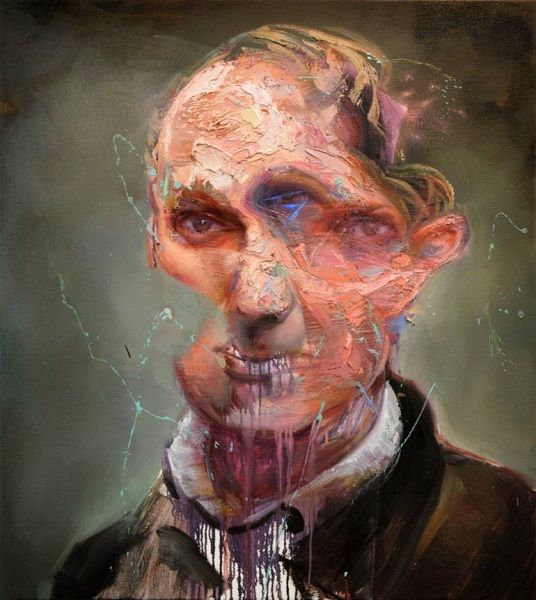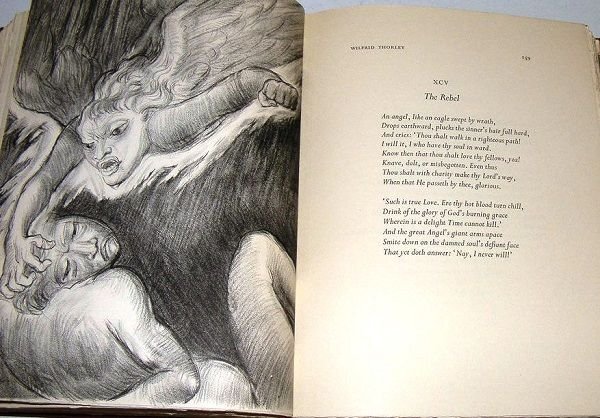Charles Pierre Baudelaire was born in Paris in 1821 in the family of a senior civil servant. His father died in 1827 and his mother re-married an officer who later worked as ambassador in different countries. Baudelaire received his education in Lyon (1831-1836) and Paris (1836-1839).

In the following years, Baudelaire leads an irregular life, believed to be sick with syphilis at the time. To get him on the right path, his conservators send him on a journey to India. After returning to Paris, Baudelaire is already mature, but continues his extravagant life, and as he is threatened with ruin, his family puts his property under custody. During this period, he met the young woman named Joanna Duval. Their relationship continued until the end of his life.
In 1845 and 1846, Baudelaire published critical reviews of contemporary art that drew attention to the courage of the stated views. He took part in the Revolution of 1848 and for some time was interested in politics, but his views went through the anarchism of Pierre-Joseph Proudhon, the story of "Raison d'État" by Giuseppe Ferrari to the ultramountain critique of liberalism by Joseph de Mestre. Meanwhile, Baudelaire's financial difficulties have increased, especially since the bankruptcy of his friend and publisher Auguste Pulee Mallasis in 1861. In 1864 he moved to Brussels where he hoped to sell the rights for his works. During this period, besides his addiction to opium, he started drinking too much. In 1866, he had a heart attack and became paralyzed. The last two years of his life he spent in sanatoriums in Brussels and Paris, where he died in 1867.
Creativity
In 1857, Baudelaire published his first and most famous poem "Les fleurs du mal". It was published by Auguste Poule Mallasis, in his printing house in Alanson. The poems are highly appreciated by a small circle of readers, but its storyline provokes the discontent of critics and the general public. The main topics of sex and immortality are considered scandalous and the book becomes a commonality for inconvenience. Baudelaire and his publisher have been judged for violating public morality. The collection of poems was reissued in 1861 with significant additions.
Baudelaire's other works include "Petits Poèmes en Prose", a series of critical articles included in the "Pays, Exposition universelle," research on the work of Gustave Flaubert, Teofil Gauthier and Honore de Balzac, articles in the collections Poètes francais“ and „Les Paradis artificiels: opium et haschisch. In the mid-1940s, Baudelaire became acquainted with the work of Edgar Allan Poe, which made him a great impression. Almost for the rest of his life he translated into French his works.

He is the first European to compare wine and drugs in aesthetic and ethical context. Baudelaire died only 46 years of age, having known in his young years in close contact and in plentiful doses the three most powerful forms of intoxication - drugs, alcohol and sex. Because of the last of the three lusts at the end of his life, he suffered from severe syphilis, and the first two related his perhaps fruitful but at the same time painful nerve disorder. We can only guess whether the poems were born from opium or from alcohol:
In my brain there walks about,
As though he were in his own home,
A lovely cat, strong, sweet, charming.
When he mews, one scarcely hears him
In addition to the noisy poetry collection "The Flowers of Evil" and a dozen remarkable aesthetic studios that have made his prominence less scandalous, Baudelaire has left three lengthy essays on the drug "Poems for hashish", "Opiumman" and " Wine and hash as a means of extending the personality ". In the three texts, without grams of shame and shyness, he describes the psychological impact of opium and hashish, carefully examining the penetration of poisons into the creases of the brain and the images they produce - "harmony in the most charming form" and "instantaneous control of paradise" his own expressions. Because of these writings today, some tend to regard him as a drug apologist, but this is neither fair nor equitable, because every time after the descriptions of the enjoyment of opium, there are also detailed and insightful descriptions of the narratives caused by the narcosis, according to Baudelaire, "the fire of a false happiness and false enlightenment" burns. He remembered that the drug is a cunning mirror, which awakens only what man actually conceals in himself and which he could find and reach without it, that is, reaching and giving away drugs is ultimately an act of cowardice. "Hashish as all lonely pleasures makes the person useless to society and incites to a constant self-esteem."
Of the three texts, the latter is the most interesting. Writing is at the latest and in it against the fraudulent fire of drugs, the poet brings the beauty, nobility and creative fertility of wine. It occurred to me to write about wine and hashish in the same article, because there really is something in common between them - the unusual stimulation of the poetic tendencies that they cause in man, says Baudelaire. He further explains that what brings the two substances together is the human attraction to any substance useful and harmful that elevates his personality, helps him to feel his greatness and to believe in him, to return at least for a moment to the lost paradise . However, between the two routes of happiness there is a significant difference - while one is quite reasonable and acceptable, the other is like a "forbidden game".
How great are the spectacles of wine, illuminated by the inner sun! How true and burning is that second youth that man draws from it! But also how formidable are its overwhelming delights and its enervating enchantments!
This enthusiastic and elevated attitude towards wine is deeply European in its essence. Long before the "clash of civilizations" was still born, this clash existed, and one of its invisible manifestations is related to the millennial civilization conflict (perhaps the more accurate word is contact) between wine and drugs. Every civilization needs its own stimulants - some peoples find it in wine, beer, and later in alcohol, while other peoples, for their own most often religious reasons, remain moderately addicted to opium.

Charles Baudelaire by Mathieu Laca
It has been proven that wine and drugs have historically been peers. From archaeological studies it has been found that the earliest used plants with psychoactivating properties are hemp (Cannabis sativa) and opium poppy (Papaver somniferum). Their cultivation began in Southwestern Asia about 4000 years ago when the first wine was born in Eurasia. In the 5th c. Herodotus describes how Scythian tribes on the Northern Black Sea coast threw hemp seeds on hot stones and then breathed the smoke that drowned them and they fell into turbulent joy. In the following centuries, the healing properties of hemp and opium poppy have been known in Europe and commonly used in medicine, but the main stimulant not only in tradition, but also in religion, remains wine. It is noteworthy that there is no evidence of cannabis in the Bible, while wine is generously present in her narrative.
The third particularly important drug in the history of civilization is the coke, whose leaves chewed the American Indians when the Spanish conquistadors stepped into their land. The encounter between the Old and the New World after the end of the fifteenth century to some extent can also be seen as a clash between alcohol and alkaloids in the leaves of the Erythroxylon coca plant.
If today we tend to absolutise the advantages and superiority of European culture and civilization to the rest of the world, it is certainly one of the real reasons for this superiority associated with wine. In contrast to the drug, which, after an illusory "personality extension" often causes its disintegration, wine has always been more fruitful and constructive and, much less, deceitful and destructive.
This is also understood by the acclaimed poet, aesthete and decadent Charles Baudelaire, and he has said it elegantly and clearly in the last of the three essays on the drug.

The wine raises the will, the hash paralyzes it. Wine strengthens physical forces, hashish is a tool for suicide. Wine makes man good and sociable, hashish pulls him to solitude. The wine, in other words, is hard-working, and hashish is essentially a lump. Why do you eventually work, plow, write, produce something when you can come to heaven and do no work? Finally, the wine is intended for people who work and who are worthy to drink it. Hashish belongs to the loneliness, it is created for the despised idols. Wine is useful and fruitful. Hashish is useless and dangerous.
Fascinating bit on Baudelaire, his drug lit classics, and his proclivity for wine.
Downvoting a post can decrease pending rewards and make it less visible. Common reasons:
Submit